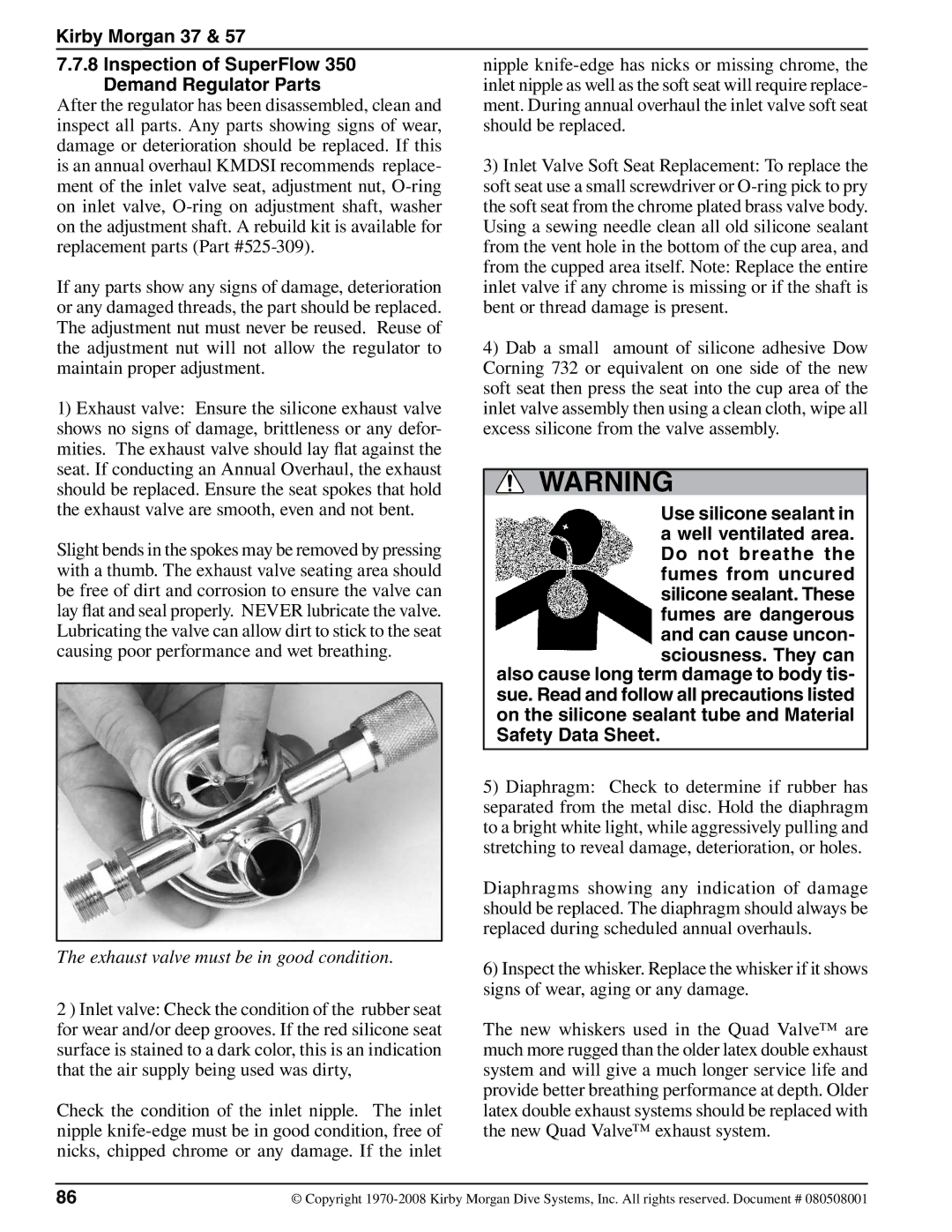
Kirby Morgan 37 & 57
7.7.8 Inspection of SuperFlow 350 | nipple | ||
Demand Regulator Parts | inlet nipple as well as the soft seat will require replace- | ||
After the regulator has been disassembled, clean and | ment. During annual overhaul the inlet valve soft seat | ||
inspect all parts. Any parts showing signs of wear, | should be replaced. | ||
damage or deterioration should be replaced. If this |
| ||
is an annual overhaul KMDSI recommends replace- | 3) Inlet Valve Soft Seat Replacement: To replace the | ||
ment of the inlet valve seat, adjustment nut, | soft seat use a small screwdriver or | ||
on inlet valve, | the soft seat from the chrome plated brass valve body. | ||
on the adjustment shaft. A rebuild kit is available for | Using a sewing needle clean all old silicone sealant | ||
replacement parts (Part | from the vent hole in the bottom of the cup area, and | ||
|
| from the cupped area itself. Note: Replace the entire | |
If any parts show any signs of damage, deterioration | inlet valve if any chrome is missing or if the shaft is | ||
or any damaged threads, the part should be replaced. | bent or thread damage is present. | ||
The adjustment nut must never be reused. Reuse of |
| ||
the adjustment nut will not allow the regulator to | 4) Dab a small amount of silicone adhesive Dow | ||
maintain proper adjustment. | Corning 732 or equivalent on one side of the new | ||
|
| soft seat then press the seat into the cup area of the | |
1) Exhaust valve: Ensure the silicone exhaust valve | inlet valve assembly then using a clean cloth, wipe all | ||
shows no signs of damage, brittleness or any defor- | excess silicone from the valve assembly. | ||
mities. The exhaust valve should lay flat against the |
| ||
seat. If conducting an Annual Overhaul, the exhaust |
| ||
WARNING | |||
should be replaced. Ensure the seat spokes that hold | |||
the exhaust valve are smooth, even and not bent. | Use silicone sealant in | ||
Slight bends in the spokes may be removed by pressing | a well ventilated area. | ||
Do not breathe the | |||
with a thumb. The exhaust valve seating area should | fumes from uncured | ||
be free of dirt and corrosion to ensure the valve can | silicone sealant. These | ||
lay flat and seal properly. NEVER lubricate the valve. | fumes are dangerous | ||
Lubricating the valve can allow dirt to stick to the seat | and can cause uncon- | ||
causing poor performance and wet breathing. | sciousness. They can | ||
|
| also cause long term damage to body tis- | |
|
| sue. Read and follow all precautions listed | |
|
| on the silicone sealant tube and Material | |
|
| Safety Data Sheet. | |
|
| 5) Diaphragm: Check to determine if rubber has | |
|
| separated from the metal disc. Hold the diaphragm | |
|
| to a bright white light, while aggressively pulling and | |
|
| stretching to reveal damage, deterioration, or holes. | |
|
| Diaphragms showing any indication of damage | |
|
| should be replaced. The diaphragm should always be | |
|
| replaced during scheduled annual overhauls. | |
|
|
| |
The exhaust valve must be in good condition. | 6) Inspect the whisker. Replace the whisker if it shows | ||
|
| ||
2 ) Inlet valve: Check the condition of the rubber seat | signs of wear, aging or any damage. | ||
The new whiskers used in the Quad Valve™ are | |||
for wear and/or deep grooves. If the red silicone seat | |||
surface is stained to a dark color, this is an indication | much more rugged than the older latex double exhaust | ||
that the air supply being used was dirty, | system and will give a much longer service life and | ||
|
| provide better breathing performance at depth. Older | |
Check the condition of the inlet nipple. The inlet | latex double exhaust systems should be replaced with | ||
nipple | the new Quad Valve™ exhaust system. | ||
nicks, chipped chrome or any damage. If the inlet |
| ||
86 | © Copyright |
